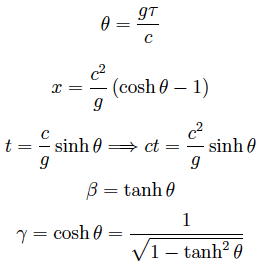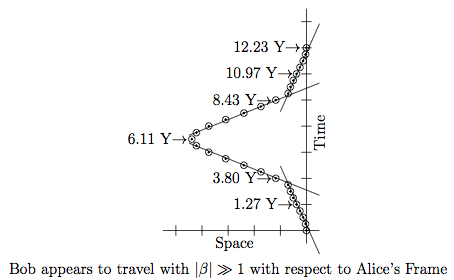Twin Paradox Unbound
Special Relativity is about "flat" TimeSpace, it is NOT about constant velocities. General Relativity is about "curved" TimeSpace, it is NOT about acceleration. Acceleration is just the process of moving from one inertial frame of reference to another inertial frame of reference.
Elementary Particles have mass via Higgs Field interactions. Elementary Particles, interacting via the Electro-Weak, and Strong forces, determine the mass of objects in the universe. The mass of these objects in turn distort TimeSpace. Distorted TimeSpace creates "gravitational" forces that influence the dynamics of stuff. That is why gravitational mass is the same as inertial mass. An interesting side note: If a gravitational binding energy is extant, then gravitational interactions are quantum mechanical and the graviton will be found someday. If gravitational binding energy does not exist, the gravitational force will never be unified with the other fundamental forces.
Flat TimeSpace admits an accountable number of inertial frames from which to contemplate any set of events. An observer is an inertial frame of reference. Various observers may label given events with different values (ct , x , y , z) but, all observers will agree upon the interval I2 = (Δct)2 - ( Δx2 + Δy2 + Δz2) between any two events.
Standard Twin Paradox
- There are no preferred inertial frames. Or, all inertial frames are equally valid.
- Alice and Bob are initially together in an inertial frame of reference.
- Bob remains stationary in that inertial frame of reference while:
- Alice moves away from Bob, to a far location, at a large constant speed.
- Alice briefly stops at that far location.
- Alice toward Bob, from the far location, at a large constant speed.
- Alice comes to rest next to Bob, and stays there.
- Bob reasons, according to Special Relativity, Alice, moving relative to him, will experience time dilation, and age less than he during the above process. And, he is able to calculate very precisely the difference in their ages.
- Alice reasons, according to Special Relativity, Bob, moving relative to her, will experience time dilation, and age less than she during the above process. And, she is able to calculate very precisely the difference in their ages.
Bob and Alice cannot both be correct, but point #1 above suggests neither possess the "truth", and "all things being relative" should create a conflict in your mind.
The Much "Easier" Constant Acceleration Case:
I prefer this version of the Twin Paradox:
- Alice's ship moves away from Bob in a way that causes Alice to feel a constant acceleration equal to g. Alice maintains this constant acceleration until her clock reads 1.75 years. As the clock reads 1.75 years she shuts off the engines for a few minutes and rotates her ship to point back towards Bob. Then, Alice restarts her ship's engines.
- Alice's ship moves away from Bob in a way that causes Alice to feel a constant acceleration equal to g. Alice maintains this constant acceleration until her clock reads 1.75 × 2 = 3.5 years. As the clock reads 3.5 years Alice's ship comes to a stop with respect to Bob and Alice leaves the ship's engines running.
- Alice's ship moves toward Bob in a way that causes Alice to feel a constant acceleration equal to g. Alice maintains this constant acceleration until her clock reads 1.75 × 3 = 5.25 years. As the clock reads 5.25 years she shuts off the engines for a few minutes and rotates her ship to point away from Bob. Then, Alice restarts her ship's engines.
- Alice's ship moves toward Bob in a way that causes Alice to feel a constant acceleration equal to g. Alice maintains this constant acceleration until her clock reads 1.75 × 4 = 7.0 years. As the clock reads 7.5 years Alice's ship comes to a stop with respect to Bob and Alice shuts off the engines.
As in the Standard Presentation Alice and Bob will disagree which is aging the slower, but the smoother transition amongst inertial frames is a bit more realistic. In fact this is what we do using Elementary Particles in our accelerators, detectors, et cetera. Welcome to my world.
The kinematic equations look a bit strange:

but, trust me, they just express the hyperbolic geometry (Euclidean Geometry just doesn't cut it.) needed to properly incorporate Time into the TimeSpace Continuum.
Alice travels smoothly away from and then toward Bob. All the while shifting from one inertial frame to the next..

Notice that from Alice's point of view Bob seems to move smoothly from zero to a large (44% the speed of light) speed and then smoothly to a super-liminal (240% the speed of light) speed. then there is that very large (physically unrealistic) acceleration before returning toward Alice.

So like the Standard Twin Paradox it is obvious which point of view has more veracity.


Comments
Thanks, PR!
I've saved your post and will study it carefully before I comment.
I'm assuming tau=proper time, related to coordinate time t by d(tau)/dt = 1/gamma(v). (see below)
theta = the angle between two frames of reference and is related to beta (yes, beta=tanh(theta))
gamma(v) = 1 /( sqrt (1 - (v/c)^2))
g = a constant acceleration (not necessarily gravity at the earth's surface.)
gamma(v) is also the factor relating relativistic to rest mass, m(rel) = gamma(v) * m(rest).
Are these your def'ns?
Just got your pdf paper, thank you very much for that as well.
Thx
td
There are known knowns; there are things we know we know. We also know there are known unknowns; that is to say we know there are some things we do not know. But there are also unknown unknowns – the ones we don't know we don't know.
Mostly correct
g ≈ 9.8 m/s2, and the numbers on the graph follow from that. I can easily (but tediously) produce examples for any other values of acceleration. Setting acceleration to g results in a nice comfortable ride for the duration.
You will need to drop the relativistic mass nonsense. Mass is mass, it is an invariant. The nonsense about "relativistic mass" is a holdover from the fiction that momentum is mass times velocity and kinetic energy is one half mass times velocity squared. Neither of those two equations are correct. They were never correct! But, pre 1915, nobody knew they were not correct. I have spent several decades trying to persuade my fellow physicists to stop teaching shit physics but nobody seems to care about quality teaching, sigh.
Thanks for reading,
Dr. Robert I. Price (AKA PriceRip)
One more thing : there must be some weird paradoxes
related to circular motion as well, which the current example of "straight-line" motion will not encompass, say the physics of synchrotron radiation.
There are known knowns; there are things we know we know. We also know there are known unknowns; that is to say we know there are some things we do not know. But there are also unknown unknowns – the ones we don't know we don't know.
Actually this is not true.
All the straight line stuff carries over into the circular motion with straightforward but tedious calculations. Rotating a frame of reference is not for the faint of heart.
Circular motion (even with varying speed) just makes the bookkeeping a big headache. Every bit of this carries over to accelerator physics. The really neat part is transformations involving rotations are exquisitely nonintuitive.